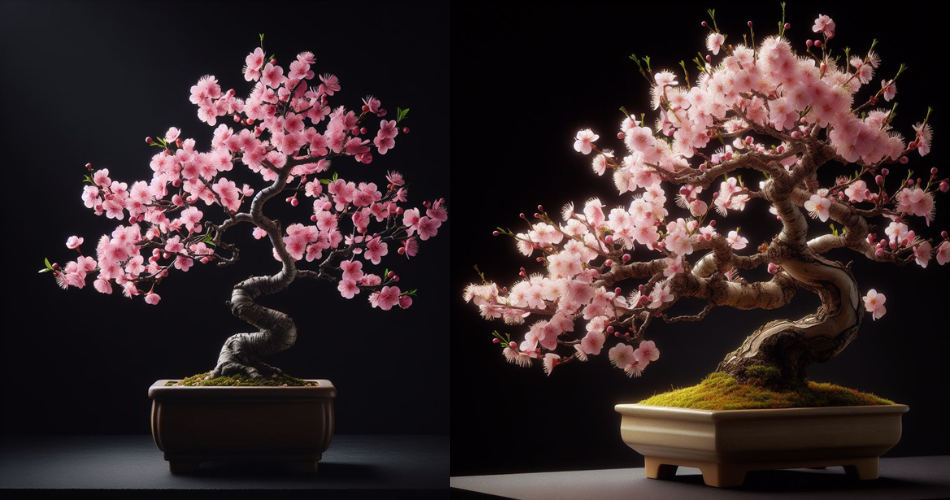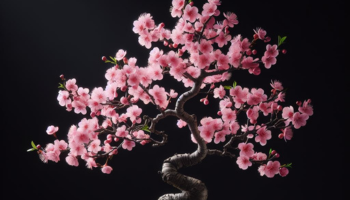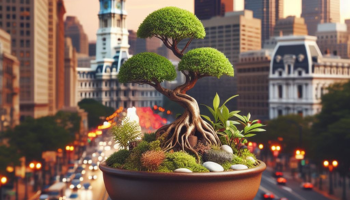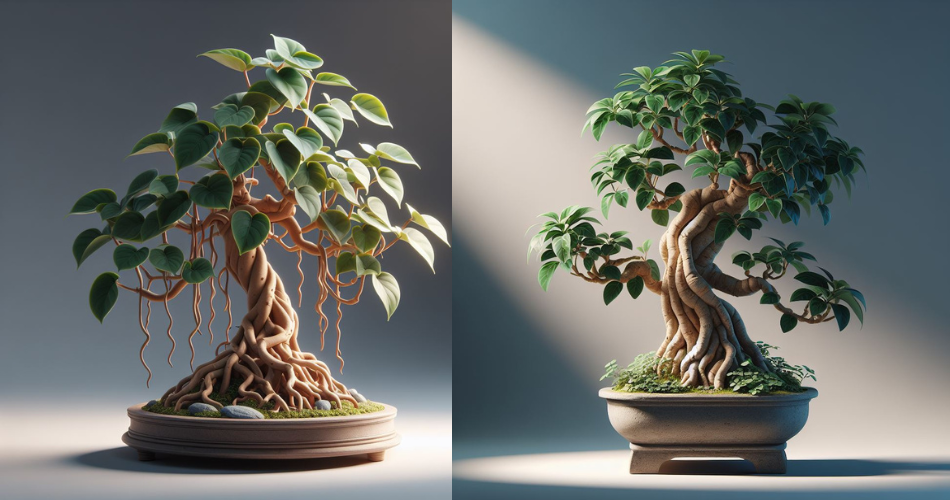
Fuji Cherry Bonsai, with its delicate blossoms and graceful branches, has captivated bonsai enthusiasts around the world. This miniature version of the beloved cherry tree offers an exquisite display of color and form, making it a favorite choice for bonsai enthusiasts of all levels. In this comprehensive guide, we will delve into the art of caring for Fuji Cherry Bonsai, exploring everything from the selection process to the essential techniques for maintaining its health and beauty. Whether you are a seasoned bonsai enthusiast or a beginner looking to embark on the rewarding journey of bonsai cultivation, this article will provide you with valuable insights and practical tips to ensure the success of your Fuji Cherry Bonsai.
1.1 Understanding the History and Significance of Fuji Cherry Bonsai
Fuji Cherry Bonsai, also known as Prunus incisa, is a tree that has captured the hearts of bonsai enthusiasts around the world. With its delicate pink blossoms and compact size, it brings a touch of elegance and grace to any garden or indoor space. Originating from Japan, this bonsai tree has a rich history and holds deep cultural significance. It symbolizes the transient nature of life and is often associated with beauty, renewal, and the arrival of spring.
1.2 Exploring the Characteristics and Aesthetics of Fuji Cherry Bonsai
The Fuji Cherry Bonsai is renowned for its petite size and stunning display of flowers. Its leaves are small and oval-shaped, with a vibrant green color that adds to its visual appeal. During springtime, the tree bursts into a profusion of pink or white blossoms, creating a breathtaking spectacle. The delicate branches and trunk of the Fuji Cherry Bonsai lend themselves well to various bonsai styles, allowing for artistic expression and creativity. Whether it’s the cascading style, formal upright, or windswept, this bonsai tree can be shaped to embody a range of aesthetic preferences.
2. Selecting the Right Fuji Cherry Bonsai: Essential Considerations
2.1 Choosing the Ideal Species and Varieties of Fuji Cherry Bonsai
When selecting a Fuji Cherry Bonsai, it’s important to consider the species and varieties available. Some popular choices include Prunus incisa ‘Kojo-no-mai’ and Prunus incisa ‘Yae-Kon-dou’. Each variety has its own unique characteristics, such as flower color and growth habit. Researching and understanding the traits of different species and varieties will help you choose the one that best suits your taste and desired aesthetics.
2.2 Evaluating the Health and Vigor of Fuji Cherry Bonsai
To ensure the long-term success of your Fuji Cherry Bonsai, it’s crucial to select a tree that is healthy and vigorous. Look for well-developed roots, vibrant foliage, and an overall robust appearance. Avoid bonsai trees with signs of disease or pests, as this can lead to future problems and difficulties in care.
2.3 Assessing the Age and Development of Fuji Cherry Bonsai
The age and development of a Fuji Cherry Bonsai can greatly impact its potential for growth and future styling. Younger bonsai trees offer more flexibility for shaping and training, while older specimens may already possess impressive trunk thickness and branching. Consider your skill level and personal preferences when choosing between a young or mature bonsai.
3. Understanding the Environmental Needs of Fuji Cherry Bonsai
3.1 Providing the Optimal Light Conditions for Fuji Cherry Bonsai
Like all bonsai trees, Fuji Cherry Bonsai thrives in bright, indirect light. Place your bonsai near a window that receives ample sunlight, but be cautious of excessive heat or direct sunlight, which can scorch the delicate leaves. If natural light is limited, you can supplement it with fluorescent grow lights.
3.2 Maintaining the Ideal Temperature and Humidity Levels
Fuji Cherry Bonsai prefers cool to moderate temperatures, ideally between 50°F to 70°F (10°C to 21°C). Protect the tree from extreme heat or cold, as it can cause stress and damage. Additionally, maintaining proper humidity levels is important for the bonsai’s health. A humidity tray or regular misting can help create a suitable environment, especially during drier seasons or indoor heating.
3.3 Creating a Suitable Air Circulation for Fuji Cherry Bonsai
Adequate air circulation is essential for the overall health of your Fuji Cherry Bonsai. Proper ventilation helps prevent fungal diseases and promotes the exchange of gases. Avoid placing the bonsai in stagnant or heavily congested areas. Regularly exposing it to fresh air, such as during outdoor periods in suitable weather, can greatly benefit its overall well-being.
4. Mastering the Art of Pruning and Shaping Fuji Cherry Bonsai
4.1 Learning the Basics of Pruning and Trimming Fuji Cherry Bonsai
Pruning is a fundamental aspect of maintaining the shape and health of your Fuji Cherry Bonsai. Regularly remove any dead, damaged, or overcrowded branches to promote proper airflow and encourage new growth. Additionally, trimming back the new growth after flowering can help maintain the desired shape and size of your bonsai tree.
4.2 Understanding the Different Pruning Techniques and Styles
There are various pruning techniques and styles that can be applied to your Fuji Cherry Bonsai, depending on your desired aesthetic. These include but are not limited to, clip and grow, thinning, and directional pruning. Research and experimentation will help you determine the best techniques to achieve your desired bonsai style.
4.3 Training and Wiring Fuji Cherry Bonsai to Achieve Desired Shapes
To shape and style your Fuji Cherry Bonsai, training and wiring techniques can be utilized. Training involves gently guiding the branches and trunk into the desired positions over time. Wiring, on the other hand, allows for more immediate shaping by using bonsai wire to hold the branches in place. Care should be taken to avoid applying excessive pressure or leaving wires on for too long, as this can damage the tree. Regular monitoring and adjustments are necessary when using wiring techniques.
By following these essential guidelines, you can cultivate and care for a beautiful Fuji Cherry Bonsai that will bring you joy and admiration for years to come. Remember, bonsai care is an art form, so embrace the journey with patience, creativity, and a touch of humor!
5. Nurturing the Health of Fuji Cherry Bonsai: Watering, Soil, and Fertilization
5.1 Establishing a Proper Watering Routine for Fuji Cherry Bonsai
Watering your Fuji Cherry Bonsai is like finding the perfect balance in a yoga pose – too little water and it’ll wither away, too much water and it’ll drown. So how do you strike that perfect balance? First, you need to understand that Fuji Cherry Bonsai prefer moist soil but not soggy. Stick your finger about an inch into the soil, and if it feels dry, it’s time to water. Don’t worry, it’s not as tricky as mastering a handstand, just keep the soil consistently moist, not bone dry or drenched, and your little cherry tree will flourish.
5.2 Selecting the Appropriate Soil Mix for Fuji Cherry Bonsai
Choosing the right soil for your Fuji Cherry Bonsai is like picking the perfect pair of shoes – it needs to fit just right. These bonsai trees love well-draining soil, so go for a mix that includes organic materials like bark, peat moss, and perlite. Avoid heavy soils that retain too much water, as they can lead to root rot and a very unhappy bonsai. And remember, it’s all about finding that perfect fit for your tree’s roots, so don’t be afraid to experiment with different soil mixes.
5.3 Understanding Fertilization Techniques for Healthy Growth
Fertilizing your Fuji Cherry Bonsai is like giving it a delicious, nutritious snack – it helps it grow strong and healthy. Use a balanced, slow-release fertilizer during the growing seasons of spring and summer. Just like we don’t gorge ourselves on a whole pizza in one sitting (or do we?), avoid over-fertilizing, as it can burn the roots of your bonsai. Follow the instructions on the fertilizer package, and your cherry tree will have all the nourishment it needs to thrive.
6. Protecting Fuji Cherry Bonsai from Pests and Diseases
6.1 Identifying Common Pests that Affect Fuji Cherry Bonsai
Uh-oh, it’s time to play detective and identify the pesky little intruders that might bug your Fuji Cherry Bonsai. Keep an eye out for aphids, spider mites, and scale insects, who seem to think your bonsai is an all-you-can-eat buffet. These critters can suck the life out of your tree, but don’t worry, we’ve got your back.
6.2 Preventive Measures to Keep Pests and Diseases at Bay
Putting up a “No Vacancy” sign for pests and diseases is easier than you might think. Keep your bonsai healthy and strong by providing proper care, including watering, fertilizing, and pruning. A healthy bonsai is like Fort Knox, impenetrable to pests and diseases. Also, make it a habit to inspect your tree regularly, catch any unwelcome guests early on, and take appropriate action.
6.3 Natural and Chemical Treatments
When all else fails and your Fuji Cherry Bonsai is under attack, it’s time to bring in the big guns. Natural treatments like neem oil and insecticidal soap can help get rid of those pesky pests and keep your bonsai in tip-top shape. If the situation escalates, you can consider using chemical treatments, but be sure to follow the instructions carefully and handle them with caution. Remember, the goal is to protect your bonsai, not unleash chaos in your garden.In conclusion, cultivating Fuji Cherry Bonsai can be a truly rewarding and fulfilling experience. With proper care and attention, this delicate tree can bring beauty, tranquility, and a sense of accomplishment to any bonsai collection. By following the guidelines outlined in this comprehensive care guide, you will have the knowledge and tools to nurture your Fuji Cherry Bonsai and watch it flourish over time. Remember, bonsai cultivation is an art that requires patience and dedication, but the results are truly worth it. So go ahead, embrace the art of caring for Fuji Cherry Bonsai and enjoy the timeless beauty it brings to your life.
FAQ
1. Can I grow Fuji Cherry Bonsai indoors?
Fuji Cherry Bonsai prefers to be grown outdoors, as it requires ample sunlight and fresh air to thrive. However, during the winter months or in regions with extreme weather conditions, it is possible to grow Fuji Cherry Bonsai indoors temporarily. Just ensure that it receives sufficient natural light and is protected from drafts.
2. How often should I water my Fuji Cherry Bonsai?
The watering frequency for Fuji Cherry Bonsai depends on various factors such as climate, pot size, and soil type. As a general rule, it is crucial to check the moisture level of the soil regularly. Water the bonsai when the top layer of soil feels slightly dry, but avoid overwatering, as it can lead to root rot. A well-draining soil mix and careful observation will help you determine the ideal watering schedule for your Fuji Cherry Bonsai.
3. Can I shape my Fuji Cherry Bonsai into different styles?
Absolutely! Fuji Cherry Bonsai can be shaped into various styles, including formal upright, cascade, semi-cascade, and slanting, among others. However, shaping should be done gradually and with careful consideration of the tree’s health and growth patterns. Pruning, wiring, and training techniques can be employed to achieve the desired shape and form of your Fuji Cherry Bonsai.
4. How do I protect my Fuji Cherry Bonsai from pests and diseases?
To protect your Fuji Cherry Bonsai from common pests like aphids, spider mites, and scale insects, it is important to regularly inspect the tree for any signs of infestation. If pests are detected, appropriate measures such as using insecticidal soaps or natural remedies like neem oil can be applied. As for diseases, maintaining proper hygiene, providing adequate airflow, and using well-draining soil can help prevent most fungal infections. If necessary, fungicides can be used, but it is always best to consult with experts or experienced bonsai growers for specific advice on pest and disease management.





